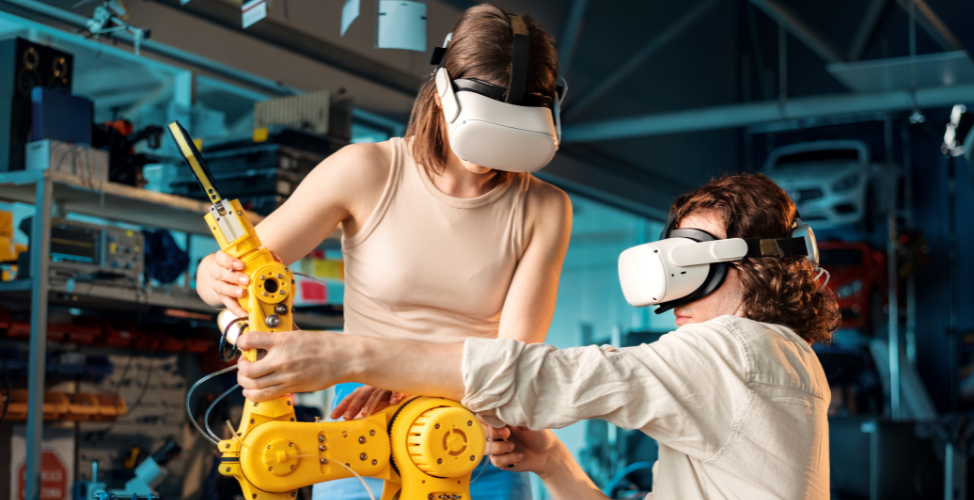Applied Generative AI for Digital Transformation: A Game-Changer for Businesses
Businesses worldwide keep chasing new ways to stand out in a busy market. They search for simpler methods, faster results, and stronger connections. Bold strategies lead the pack. Right now, applied generative ai for digital transformation ranks high on that list of bold solutions. It has turned into a sought-after approach to help businesses reshape their daily tasks and create fresh value. In this post, we will explore how this technology works, where it applies, and why it matters.

Understanding Generative AI and Its Role in Digital Transformation
Why is AI so popular now? Smoother processes, better experiences, and cost savings are always top of mind. Generative AI is revolutionizing how these aims come to life. Its adaptability and speed fit neatly into a world where competition rarely slows down.
Defining Generative AI
Generative AI is software that creates new outputs, whether text, audio, or visuals, based on patterns learned from past examples. It learns how humans write, speak, or draw, then it replicates that style in fresh content. Its results often sound or look almost human-made.
Applied generative AI for digital transformation is changing the game for creative workflows. By training on vast amounts of real-world data, generative AI learns subtle patterns that guide it to produce content that feels natural and engaging—not robotic. What once took teams weeks to brainstorm, like marketing slogans or design concepts, can now be generated in just hours with the right prompt. This speed and creativity mark a major leap forward, showing how applied generative AI is accelerating digital transformation across industries.
The Intersection of Generative AI and Digital Transformation
Digital transformation has been a buzzword for ages, yet many firms still struggle with it. They patch old systems and layer them under a modern interface. That approach only solves part of the puzzle. Real transformation demands a complete re-think of data flows, staff roles, and technology usage.
That’s where applied generative ai for digital transformation truly shines. This AI fosters collaboration between teams, speeds up routines, and shakes up stale operations. It doesn’t just automate steps, it also reimagines them. The results show up as quicker sales, smarter customer support, and streamlined processes. Each success story brings more examples of AI’s potential to reshape entire industries.
Watch more: What does the Generative AI Ecosystem Refer To? Key Components & Insights
Practical Applications of Generative AI in Business
Businesses often rely on manual tasks that slow things down. The solution can be found in generative AI, which addresses time-consuming chores and turns them into neat, efficient workflows.
Content Creation and Personalization
Long hours on blog drafts or product descriptions can sap a team’s time. Generative AI shortens that process by generating a near-finished draft for refinement. Marketers add brand tone and final touches, saving hours of work.
Even better, this AI boosts personalization. It recommends relevant items, crafts dynamic emails, and adjusts website text for unique customers. This level of tailored content was once expensive to produce, but AI has removed that barrier.
Within the realm of content, you can also feed brand guidelines. The AI then respects the brand’s style, color, or voice. This fosters unity across marketing campaigns. In a modern environment, brand consistency gains trust. AI-based personalization cements that bond.
Product Design and Development
Developing a new product calls for creativity. R&D teams dig for original ideas, build prototypes, then test them. Each step can consume large portions of the budget. Generative AI refines this cycle. It studies design parameters, user preferences, and existing products. Then it proposes new ideas that align with brand identity and target market tastes.
Engineers also harness the AI for specialized tasks, such as shape optimization or simulation. By generating multiple options and testing them virtually, the team decreases errors before physical production. This reduces wasted materials and speeds up time to market.
Let’s say a car manufacturer is designing a new model. The AI digital transformation offers suggestions for interior layout, exterior lines, or aerodynamic shapes. It tweaks these suggestions based on user feedback. The outcome is a final design that meets function and style requirements without endless rounds of guesswork.
Customer Service Enhancement
Customers expect immediate help. Delays can lead them to jump to a competitor. Many firms turn to chatbots, but older versions are limited by standard scripts. Today, generative AI supercharges chatbots so they can tackle more detailed questions with a human touch.
Applied generative ai for digital transformation in customer service rewrites the script. Bots learn from prior interactions, adapt to new queries, and store context. They reference user history to give relevant answers in seconds. This instant response improves satisfaction. It also frees human agents to handle truly complicated issues.
Plus, generative AI chatbots can add personality or empathy while they talk. They might greet repeat customers by name or recall their last orders. This personal feel blurs the lines between human and AI-based help.
Case Studies: Generative AI in Action
Theory holds limited power compared to real stories. Let’s look at two recognized brands that used generative AI to sharpen their operations.
NatWest’s Collaboration with OpenAI
NatWest, a major UK lender, faced rising fraud. Traditional call centers could not handle the constant flood of suspicious activity alerts. So, NatWest teamed up with OpenAI to create a generative AI system that processes fraud reports in real time.
The AI learns from each incident, automatically detecting suspicious activity patterns. Customers can now report issues fast through a digital portal. The system shortens queues and blocks future attempts. Meanwhile, employees focus on deeper fraud investigations instead of mundane tasks. This step reveals how generative AI can tame large data sets and speed up resolution times.
Adobe’s AI-Powered Creative Tools
Designers around the globe rely on Adobe for their creative tasks. Lately, Adobe embedded advanced AI in its suite of products to reduce manual editing. This approach involves analyzing existing user actions and recognizing patterns. Then the AI suggests relevant filters or design templates on the fly.
Teams can swiftly edit images, auto-generate backgrounds, or apply styles that fit brand guidelines. This convenience is ideal for agencies that juggle multiple client briefs. If you want to learn more about Adobe’s advanced solutions, check out Adobe’s AI-Powered Creative Tools for deeper insights on how their partner ecosystem supports next-level creativity. Through advanced AI, Adobe customers enjoy faster turnaround and a smoother design workflow.
See more: How Generative AI Architecture Powers Advanced AI Models
The Future of Generative AI in Business
The business world is not static. Economies shift, tech evolves, and consumer demands jump around. Gen AI is not merely an option but an ongoing wave that will keep shaping operations for many years.
Continuous Evolution and Integration
Generative AI constantly learns. The more data it observes, the sharper it gets. That means new uses will emerge. We already see examples in code writing, user experience, and even voice-based tasks. This is no one-and-done integration. It’s a continuing journey where companies refine how the AI sits inside each department.
Applied generative ai for digital transformation is not a short project. It becomes a cycle of feedback, performance checks, and updates. A robust integration might require teams to adjust their processes, gather new data, or revise workflow steps. That’s progress. Each iteration leads to fewer errors and a better user experience.
Preparing for an AI-Driven Future
Automation can spark fear, including concerns about job replacement. But it also unlocks new career paths, especially in data analysis, AI training, or oversight roles. The potential to improve daily tasks is huge, but leaders must handle the shift responsibly.
It is smart to begin with a pilot. Identify a department primed for improvement. Maybe you want to transform social media content creation or generate product prototypes. Involve the staff early, ease them into the workflow changes, and gather feedback. Once you see results, scale it to other departments. This gradual approach reduces friction and builds trust in AI’s benefits.
SmartOSC – Your Strategic Partner for Generative AI-Driven Transformation
Sometimes the hardest part is not the AI itself, but the big plan around it. That is where SmartOSC steps in. We bring years of experience in digital transformation, weaving AI solutions with the business side. We don’t just install software; we make sure each piece aligns with your culture, your workflows, and your people.
SmartOSC also guides leaders through the design, training, and rollout of generative AI. We know that each company is unique, so we customize the plan for you. That includes spotting quick wins, training your teams, and measuring progress. You won’t be left guessing or stuck mid-integration.
Whenever the topic of generative AI surfaces, many wonder if it’s just hype. SmartOSC’s track record shows real success. We merge deep expertise with an agile approach to solve your everyday needs. By blending AI with data from your apps, we help you predict consumer trends, optimize marketing, and reduce overhead. The result is a leaner and more confident organization.
Better still, SmartOSC works hand in hand with major tech providers. That ensures your generative AI aligns with top security standards and global best practices. We stay ahead without risking data or brand image. One advantage is their cross-industry perspective. We’ve set up solutions for finance, healthcare, and retail, among others. This broad view means we have a ready answer for almost any challenge.
Applied generative ai for digital transformation calls for a partner that can see the big picture. SmartOSC does exactly that. And they deliver results that help your staff feel comfortable, not overwhelmed. Because once your team embraces AI, they’re motivated to see how it can further boost their daily tasks.
Conclusion
There was a time when advanced AI felt like a dream. Today, we see applied generative ai for digital transformation happening across many fields, driving better workflows and new revenue. From content and product design to everyday service tasks, it has changed how businesses shape their future. Firms that embrace it set themselves up for growth, while those who ignore it risk lagging behind.
You might be ready to bring generative AI into your own enterprise. That step can spark concerns about costs, staff training, and outcomes. Yet these challenges fade with a good plan and reliable guidance. SmartOSC stands ready to lead you through this process. Tap into our proven strategies and calm approach. Let us help you uncover all the gains AI can deliver for your business. Contact us to start your AI journey today.


